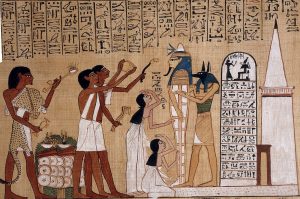5 Ancient Egyptian beliefs and practices by Billy Longer
1. Ancient Egyptian gods and belief systems

Neith purificando a Duamutef, caja canópica del British Museum by Jl FilpoC, (CC BY-SA 4.0)
| Curriculum context | VCE Unit 2: Ancient Egypt (VCAA, 2020) |
| Historical thinking concepts | Explore historical perspectives
Ask and construct historical questions |
| Historical context | The Double Crown: Kingship in Old Kingdom Egypt from the Early Dynastic Period (2920 BCE) concluding at the end of the First Intermediate Period (2040 BCE)
Cultural beliefs and practices and their expression of authority, such as cults of Re and Osiris, Egyptian beliefs concerning the afterlife, features of funerary practices and customs, royal tombs and tombs of the nobility, science, literature, art and architecture |
| Learning intentions | Develop an understanding of ancient Egyptian belief systems.
Ask and use a range of historical questions to investigate features of ancient Egyptian beliefs. Evaluate the effect that polarising perspectives may have on how one might gain favour with a god. |
Activity
Part 1: Classroom discussion and introduction to topic
Some relevant provocative questions the teacher can ask the students could include, but is not limited to:
- What belief systems do people have around the world?
- What are some First Nations people’s beliefs that you may be aware of or have learned previously at school?
- What do you know already about ancient Egyptian belief systems?
- What are some of the ancient Egyptian gods?
Part 2: Individual research activity, using historical questions
Students will individually choose one ancient Egyptian god that they’re interested in to research and answer these historical questions:
- Descriptive:
- What is the name of the god you have chosen? What does your god look like? What do they symbolise?
- Procedural:
- How was your ancient Egyptian god worshipped in daily life and official ceremonies?
- Comparative:
- Compare the pantheon of ancient Egyptian gods with that of other belief systems around the world today. What are the similarities? What are the differences?
- Evaluate:
- Evaluate the impact that the ancient Egyptian belief system had on their daily life.
The students can use the following sources as a starting point for information:
Religion and gods in ancient Egypt
11 Egyptian Gods and Goddesses
Part 3: Thinking task and extended writing response
Imagine you were a pharaoh living in ancient Egypt. Under what circumstances might you wish to gain favour from the gods? How would you gain favour from your god?
Now imagine that you were a peasant living during that time, how might your answers to the above questions be similar or different?
Part 4: Asking historical questions
Write three historical questions that you would be interested in uncovering, with regards to ancient Egyptian belief systems and the god that you have chosen or a god that you wish to learn more about. These questions should relate to areas that you’re interested in finding more information about.
Part 5: Discussion circle
Students will sit side-by-side in a circle and discuss the ancient Egyptian gods that they have researched and share their thoughts during the thinking task and historical questions that they wondered about. Students are encouraged to offer insights and share additional information or areas of interest which they may have stumbled upon during their own research activity. If a student feels that they can answer a question that their peer has shared, they are encouraged to do so.
If students have any questions left unanswered, they are encouraged to use the remainder of the class to research them. The teacher can also be used as a resource to point them in the right direction. While this is ongoing, students are encouraged to share their findings with the class and ask questions or share insights that are relevant to the topic.
References
Australian Museum. (2021). Religion and gods in ancient Egypt. https://australian.museum/learn/cultures/international-collection/ancient-egyptian/religion-and-gods-in-ancient-egypt/,
Britannica, T. Editors of Encyclopedia. (2017). 11 Egyptian Gods and Goddesses. Encyclopedia Brittanica. https://www.britannica.com/list/11-egyptian-gods-and-goddesses
VCAA. (2020). VCE Study Design: History 2022-2026. Victorian Curriculum and Assessment Authority. https://www.vcaa.vic.edu.au/curriculum/vce/vce-study-designs/history/Pages/index.aspx
2. Ancient Egyptian customs and funerary practices

Opening of the mouth ceremony by British Museum (CC0 1.0)
| Curriculum context | VCE Unit 2: Ancient Egypt (VCAA, 2020) |
| Historical thinking concept/s | Analysing sources
Using sources as evidence Explore historical perspectives Construct historical arguments |
| Historical context | The Double Crown: Kingship in Old Kingdom Egypt from the Early Dynastic Period (2920 BCE) concluding at the end of the First Intermediate Period (2040 BCE). |
| Learning intentions | Close analysis of an image as a source.
Understand how sources can be used as evidence to make a formulated opinion. Gain an understanding of ancient Egyptian funeral ceremonies and Egyptian beliefs concerning the afterlife during this period. |
Activity
Part 1: Source analysis
View this image depicting the ancient Egyptian “The Opening of the Mouth” ceremony.
Source A: ‘Book of the Dead of Hunefer (Hw-nfr) frame 3; fully coloured vignettes; coloured border. The scene (vignettes) shows episodes in Hunefer’s judgement.’ Field Collection by: Antoine Barthélemy Clot, The Trustees of the British Museum.
Analyse the above image, and answer the following historical questions:
- What is happening in this image?
- Who is represented in this image? How are they represented?
- Which ancient Egyptian god is present? Why?
- What is the role of the women depicted in this image? How does this differ from the roles of the men?
- Who do you think drew this image? Why?
- -ow influential do you think the ancient Egyptian pantheon is on the art and architecture of the period, argue your position.
Part 3: Class discussion
Students are encouraged to share their thoughts surrounding the above image. When a student shares an opinion, the teacher should ask them why they came to that conclusion. For example, if a student suggests that the image depicted could be a funerary ceremony, ask them to elaborate on the specific elements of the image that they’ve analysed, which has led them to this conclusion.
Part 4: Use sources as evidence: extended writing response
Using the image once more, and the secondary sources provided below, what might they reveal about power, beliefs, and values in ancient Egypt? Use these questions below and the sources provided to help guide your response. Feel free to expand your research and include additional sources.
- What were the beliefs surrounding the afterlife in ancient Egypt, and how were they expressed during funeral ceremonies?
- How were the tombs of pharaohs and royalty prepared and decorated, and for what purpose?
- Compare and contrast the funerary practices of ancient Egypt to another society/culture. What is each culture’s view on the afterlife and how was that reflected in their burial customs?
- What was valued during these elaborate ceremonies?
The sources below can be accessed for additional advice and assistance, although students are encouraged to explore additional sources.
References
Australian Museum. (2021). Funerals in ancient Egypt.
Mark, J. J. (2013). Ancient Egyptian Burial. World History Encyclopedia. https://www.worldhistory.org/Egyptian_Burial/
VCAA. (2020). VCE Study Design: History 2022-2026. Victorian Curriculum and Assessment Authority. https://www.vcaa.vic.edu.au/curriculum/vce/vce-study-designs/history/Pages/index.aspx

